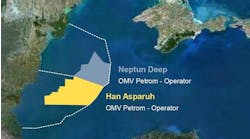Petrobras offers clarifies presalt layer production definitions
Offshore staff
RIO DE JANEIRO – Petrobras notes that the National Oil, Gas and Biofuels Agency (ANP) has a presalt production concept that differs from the company’s version.
Petrobras considers microbial carbonates located below the salt layer as the presalt reservoirs.
The agency, however, also includes wells that produce oil from geological formations known as coquinas, mainly located in the old fields of theCampos basin.
Of the six wells currently producing from coquina formations, three are in the Linguado field, one is in the Trilha field, and two are in the Pampo, all in the Campos basin. Their combined total production amounts to about 1.2 MMb/d.
According to the ANP, 25 wells produced from the presalt layer in September, and 27 wells produced in October. This increase in the number of wells was due to the Accelerated Production System (SPA), connected to well LL-07, coming into operation on Oct. 26. This well contributed for four days to the monthly production in October.
Petrobras also performed a formation test in well ANP-01, in the Franco area, which lasted just 72 hours. So, the effective production increase was only the short-lived production from well LL-07, since the Franco well was closed after the aforementioned test had been completed.
Petrobras said that there was a reduction in the total production from the presalt layer, due to operational problems in a compressor on the FPSO Cidade de Angra dos Reis, which is operating in the Santos basin's Lula field. The company stated that the problem in November was resolved and, on Nov. 22, a new presalt daily production record was registered, of 362,300 b/d.
November also saw the setting of a new presalt monthly production record, at an average of 339,000 b/d, thanks to the contribution of LL-07 throughout that month and the entry into operation of an SPA connected to the RJS-678 well and pumping to the FPSO City of São Vicente.
The daily record of 362,300 b/d was obtained from 21 producing wells, with the Santos basin presalt layer contributing 185,400 b/d from eight wells, making an average of 23,200 b/d per well. Of the eight, the production of two wells, connected to SPAs, is restricted due to limitations on gas flaring. Meanwhile, the Campos basin presalt layer contributed 176,900 b/d from 13 wells, at an average of 13,600 b/d per well.
Petrobras reported that, in October, the oil production from all of its fields in Brazil averaged 1.96 MMb/d, remaining stable in relation to its production in September (1.979 MMb/d). Taking into account the volume operated by Petrobras for its partners, production reached 2.019 MMb/d, down 1.2% from September (2.044 MMb/d).
This production variation was due to the temporary shutdown of two compressors, one on FPSO Cidade de Angra dos Reis, in the Lula field, and the other on FPSO Cidade de Itajaí, in the Baúna field, both located in the Santos basin. Operations on both FPSOs are now normalized.
12/04/2013


